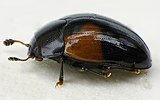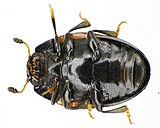Red-spotted rottenwood beetle
| Red-spotted rottenwood beetle | ||||||||||||
|---|---|---|---|---|---|---|---|---|---|---|---|---|

Red-spotted rottenwood beetle |
||||||||||||
| Systematics | ||||||||||||
|
||||||||||||
| Scientific name | ||||||||||||
| Tritoma bipustulata | ||||||||||||
| ( Fabricius , 1775) |

|

|
| Fig. 1 top view | Fig. 2 side view |

|

|
| Fig. 3 front | Fig. 4 bottom |
The red-spotted rottenwood beetle ( Tritoma bipustulata ) is a beetle from the Erotylidae family (mushroom beetle). The genus Tritoma comprises 13 species worldwide , only two of which are found in Europe. The little beetle lives on tree sponges .
Physique of the beetle
The shape of the beetle resembles a ladybird with a slightly pointed tip and is 3.5 to 4 millimeters long. It is black except for two red spots. The top is bare and shiny.
The head is partially retracted into the pronotum. The eyes are finely faceted. The eleven-part antennae do not reach the rear edge of the pronotum. They end in a tripartite club. These and the basal part of the antennae are black, the rest of the antennae are red. The base link of the club is triangular, the middle link crescent-shaped and slightly larger than the round end link.
The end part of the four-part jaw palpation is widened broadly in a hatchet. The lip buttons are tripartite, their end link is egg-shaped.
The pronotum is indistinctly bordered on the sides, unedged at the base. Like the head, it is scattered and moderately coarsely dotted .
The wing covers have a large red spot in the front area, which varies in size and shape. It is wide on the outside of the wing base. In the case of the shoulder bump, a small area of the red spot is usually darkened. There is usually a clear gap between the spot and the label and the suture of the wing cover, but the two spots can also flow together to form a wide band. Then the rear edge of the head and most of the pronotum as well as the antennae, legs and abdomen are red. Each wing cover has eight narrow point strips, of which the three outer ones do not reach the base of the wing cover. The intervals between the dot stripes are fine and scattered dotted.
The abdomen is densely dotted below (Fig. 4) and slightly hairy. The hips of all pairs of legs are widely separated. The front hip is transversely oval, and deflected into a closed front hip cavity. The hind hips are transverse. The rails are rounded on the outside at the tip and have short spines placed there like a comb. The red tarsi are all five-limbed, but the fourth limb (colored red in Fig. 5) is small and, together with the base of the claw limb, enclosed in the third tarsal limb, so that the tarsi appear to be four-limbed.
Notes on the name
The species was first described by Fabricius in 1775 using binary nomenclature . Fabricius also defines the genus Tritoma by the construction of the mouthparts and the feelers. As the first of nine species of the new genus, he describes bipustulata and begins the description with Tritoma atra, elytris macula laterali coccinea ( Latin black tritoma with a red spot on the side of the elytra). This explains the species name bipustulāta (Latin with two pustules) and the German part of the name red spots .
After this characterization, Fabricius explains Tritoma in a new line . Geoff. Ins.I . According to the customs of the time, he expresses that the species he describes is the beetle, which Geoffroy described as the Tritoma . This is followed by a detailed description of Tritoma bipustulata , which, however, does not go into the structure of the legs.
In his description of Tritoma , la tritôme ( fr. ) 1762, Geoffroy does not yet use the binary nomenclature introduced by Linnaeus . Tritoma is from old gr. τρί “tri” for “three” and τομή “tomē” for “cut” and means three parts. Geoffroy himself explains this name by the fact that the beetle he called Tritoma is the only one besides the ladybirds to have tripartite tarsi (which is only correct for the males, but Geoffroy only had one specimen available). In addition, the tritoma he describes does not have two yellow spots in total, but two on each wing-cover. The name is used by Geoffroy for a different beetle (today Mycetophagus quadripustulatus ,) than by Fabricius. Fabricius takes the name of Geoffroy and transfers it to the genus.
biology
The species is found on and in tree sponges, often on lying and decaying trunks and stumps of oak and beech . It has also been found under fungal bark, on fence posts and on branches. The beetle feeds on the fruiting bodies of the stem porlings , leaf porlings and tangles . The beetles overwinter and can appear in early spring. With regard to finding suitable habitats, the experiment with the Trametes versicolor fungus showed that the beetles react to both the fragrance components mainly given off by younger and mainly older fungi by increased antennae activity.
Beetles and larvae feed on the mushrooms. There are three different larval stages. Pupation takes place in the mushrooms. The beetles can be found all year round, but are most common in May and June.
The species is parasitized by Brachyserphus parvulus . The beetles can expel a secretion that is clear, odorless and easily volatile through glands, which each have an exit pore at the four corners of the pronotum. In the experiment, this only happens with direct contact, but can be provoked several times in a row. If the abdomen is irritated, a clear, foul-smelling and easily volatile secretion can also be excreted. A corresponding gland could not yet be found, the chemical analysis showed a close match with the body lymph. Some components of both the abdominal excretions and the excretions of the pronotum have been shown to have a deterrent effect on the yellow meadow ant . Further tests also showed antimicrobial effects.
In Austria, the two mites Urodiaspis tecta and a species of the genus Uroobovella were found on the red-spotted buckthorn beetle .
distribution
The species is distributed in Europe from Sicily to Lapland. However, there are no reports from many countries, especially in Eastern Europe.
literature
- Heinz joy, Karl Wilhelm Harde, Gustav Adolf Lohse (ed.): The beetles of Central Europe . tape 7 . Clavicornia. Spektrum Akademischer Verlag, Munich 1967, ISBN 3-8274-0681-1 . P. 105
- Klaus Koch : The Beetles of Central Europe Ecology . 1st edition. tape 2 . Goecke & Evers, Krefeld 1989, ISBN 3-87263-040-7 . P. 177
- Gustav Jäger (Ed.): CG Calwer’s Käferbuch . K. Thienemanns, Stuttgart 1876, 3rd edition p. 588
- Wolfgang Willner: Pocket dictionary of the beetles of Central Europe . 1st edition. Quelle & Meyer, Wiebelsheim 2013, ISBN 978-3-494-01451-7 . P. 248
- Jean Théodore Lacordaire: Monograph des Erotyliens, famille de l'ordre des Coleéoptères Paris 1842 p. 221
Individual evidence
- ↑ a b Tritoma bipustulata in Fauna Europaea. Retrieved November 30, 2013
- ↑ Tritoma at BioLib
- ↑ Tritoma in Fauna Europaea. Retrieved November 30, 2013
- ↑ a b J. Ch. Fabricius: Systema entomologiae, sistens insectorvm classes, ordines, genera, species, adiectis synonymis, locis, descriptionibvs, observationibvs . Flensburg, Leipzig 1775 at GDZ, on page 104: 68 as No. 1 of the genus Tritoma
- ↑ Sigmund Schenkling: Explanation of the scientific beetle names (species)
- ↑ a b c EL Geoffroy: Histoire abrégée des insectes qui se trouvent aux environs de Paris; dans laquelle ces animaux sont rangés suivant un ordre méthodique . Tome 1, Paris 1762 at GDZ p. 369: 335 f
- ↑ Sigmund Schenkling: Explanation of the scientific beetle names (genus) .
- ↑ a b J. Th. Lacordaire: Monograph des Erotyliens, famille de l'ordre des Coléoptères . Paris 1842 Google e-book p.219
- ↑ Kai Drilling, Konrad Dettner: Electrophysiological responses of four fungivorous coleoptera to volatiles of Trametes versicolor: implications for host selection. Chemoecology, 19, pp. 109–115, 2009 doi: 10.1007 / s00049-009-0015-9 [1]
- ↑ H. Mitter: Notes on the biology and distribution of the Erotylidae and Biphyllidae (sponge beetles) in Upper Austria (Coleoptera: Erotylidae, Biphyllidae) . Denisia, 13, pp. 239-245, 2004 PDF
- ↑ Piotr Wegrzymovics: Morphology, phylogeny and classification of the family Erotylidae based on adult characters . Genus, Vol 13, 4, pp. 435–504, Wrocław 2002 PDF ( Memento of the original from July 18, 2011 in the Internet Archive ) Info: The archive link was inserted automatically and has not yet been checked. Please check the original and archive link according to the instructions and then remove this notice.
- ↑ Kai Drilling: Tritoma bipustulata Fab. 1775 (Coleoptera, Erotylidae): a new host species for Brachyserphus parvulus (Nees, 1834) (Hymenoptera, Proctotrupidae) . Entomological News and Reports, 53, 2, pp. 126–127, 2009 [2]
- ↑ Kai Drilling: Exocrine glands in Erltylidae (Coleoptera, Cucujoidea). Chemical ecology, morphology and evolution . Dissertation to obtain the scientific doctoral degree at the Faculty of Biology, Chemistry and Geosciences at the University of Bayreuth, Bayreuth 2010
- ↑ Alois Koopfler, Karl Schmölzer: On the knowledge of phoretic mites and their carriers in Austria . Reports of the nat.-med. Innsbruck Association, Vol. 87, pp. 133–157, Innsbruck 2000 PDF
Web links
- Art page at ARGE SWD
- at www.natur-in-nrw.de
- at insect box
- Tritoma bipustulata inthe IUCN 2013 Red List of Threatened Species . Posted by: Mannerkoski, I., Hyvärinen, E., Alexander, K., Büche, B., Mico, E. & Pettersson, R., 2009. Retrieved February 17, 2014.
